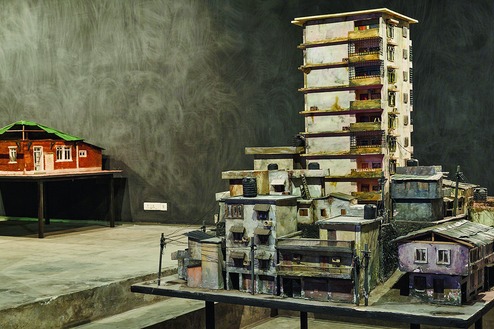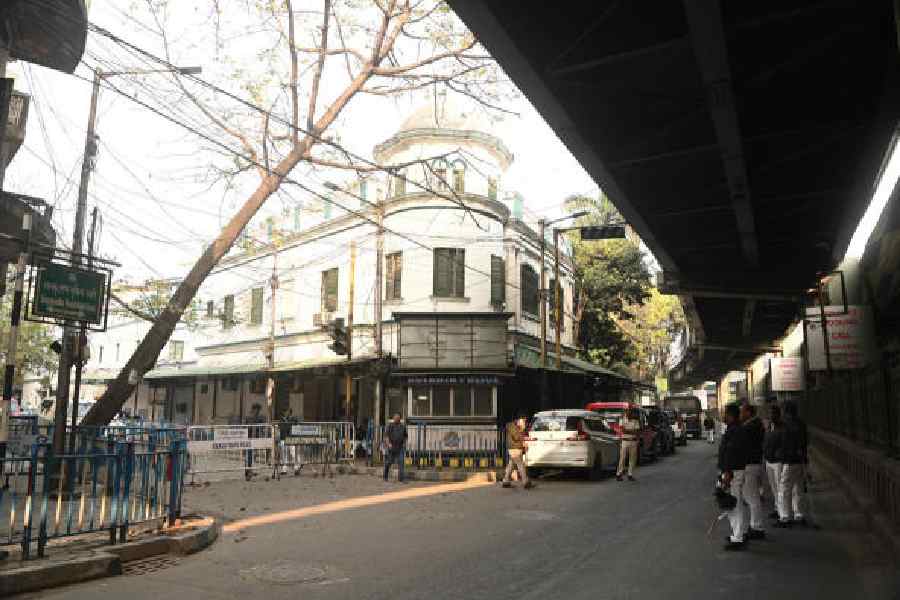
The very first view is stunning. As you enter through the door of Experimenter gallery there, from the pit, rises this seedy, tightly packed-in, claustrophobic, 72"x72"x60" cluster of tenements and shacks, every minute detail in place. Right down to foggy window panes, discoloured walls, rickety balcony railings, half-torn posters of tuition classes, leaning electrical poles, yucky public toilets that leave splotchy trails outside - whose imagined stench assails you all too readily - and similar signs of a depressingly real, underclass locality that co-habits with metropolitan glitter anywhere. Young Sahil Naik from Goa,whose solo is on till January 10, 2018, is, as you can see, driven by an off-kilter passion for constructing models of queasy, disconcerting, jaw-dropping verisimilitude.
The only thing missing from this miniature cinema set is life, for no living creature is in sight. It's this eerie, one could say strident, absence of life in a very lived-in complex that stokes unease. But no hasty exodus is suggested. No flight after bomb blasts. Nor a hasty retreat before marauders. What's indicated is a systematic and wholesale evacuation. Perhaps government-dictated and devised. Which means this isn't about a new mall, a fancy high-rise or even a new airport: the juggernaut of a haywire development that increasingly gobbles up farmland and settlements of the urban poor. Hence, darker thoughts follow from the title, Lazaretto. Is this site chosen for nuclear tests - as the Micronesian Island chain was - for which locals have forcibly been shifted, sacrificing home and hearth, however dilapidated? Or has some environmental disaster or pestilence doomed the air, water and soil of this place, scaring off even birds and strays? The artist opens with a gripping prologue but remains tantalizingly reticent, offering no easy answers to the dystopian fabulation around what is but mere architecture.
But then architecture can hardly remain inert, antiseptic and anonymous as it acquires a persona bloating into myths through location, look and living that carry defining parameters: of class and community; education and struggle - or the lack of it - sometimes prompting facile judgments about safety and health. It's this resonance around buildings that the artist's keen antennae are tuned to. Perhaps because in no other phase in the life of the Republic have architectural structures been so fraught with emotive issues of identity.
Another work, Ground Zero: Workspace, investigates with scientific distancing, the effect of a bomb - obviously low-intensity - on a room said to be his studio. The blast itself has been filmed and the damaged structure meticulously reconstructed with many kinds of material into a miniature theatre set of picturesque chaos. This, too, harks back to history: to Operation Doorstep, for example, carried out in 1953 near sites of nuclear tests in Nevada. Naik's intention, in this case, is spelt out in a parenthesis where he wryly labels the artist a suspect/bomber. Such subversive acts, taking place everywhere, are viewed as a phenomenon that goes beyond blinkered conclusions and panic prescriptions.
When he constructs a miniature home - a kitchen, a dining room and a sitting room - in three works titled Portraits of Home, with one wall in each case ripped off, he forces you out of your comfort cocoon and into war zones and earthquakes, not to mention buildings that collapse due to other reasons. The space within the four walls of a home is invested with sanctity; with the promise of permanence. But the artist plays malevolent god and throws the rooms into violent disorder. Their intimate, idiosyncratic little signs of daily living are strewn everywhere, imbued with a mocking irony. Delusions of control make you forget the fine print: that life is a hostage to chance.










